
craftsman manual miter saw
The Craftsman Manual Miter Saw is a versatile, precision-cutting tool designed for woodworking enthusiasts. Known for its durability and accuracy, it excels in various woodworking projects. This guide provides an in-depth exploration of its features, operation, and maintenance.
1.1 Overview of the Craftsman Manual Miter Saw
The Craftsman Manual Miter Saw is a durable, manually operated tool designed for precise angled cuts in woodworking. Its compact design and robust construction ensure accuracy and control. Suitable for cutting wood, plastic, and soft metals, it features a sturdy base, adjustable fences, and a sharp blade for clean results. Ideal for DIY enthusiasts and professionals, it excels in making precise miter and crosscuts. Its ease of use and reliability make it a valuable addition to any workshop or home improvement project.
1.2 Importance of Manual Miter Saws in Woodworking
Manual miter saws are essential for precise, clean cuts in woodworking. They offer accuracy and control, making them ideal for intricate projects like furniture and trim work. Unlike powered saws, manual miter saws are cost-effective and require less maintenance. Their portability and ease of use in various settings, such as workshops or job sites, add to their versatility. Additionally, they allow woodworkers to develop skill and precision, making them a valuable tool for both professionals and hobbyists. Their ability to handle different materials, including wood, plastic, and metal, further highlights their importance in woodworking projects.
1.3 Brief History of Miter Saws and Their Evolution
Miter saws have a rich history dating back to ancient woodworking techniques. Early versions were simple handheld tools used for precise angled cuts. The modern miter saw evolved in the 20th century, with powered versions becoming standard. Manual miter saws, like the Craftsman model, retain traditional appeal while incorporating modern materials and designs. Over time, advancements in blade technology and ergonomics have enhanced accuracy and usability. Today, manual miter saws remain popular for their portability and cost-effectiveness, offering a bridge between traditional craftsmanship and contemporary woodworking needs.
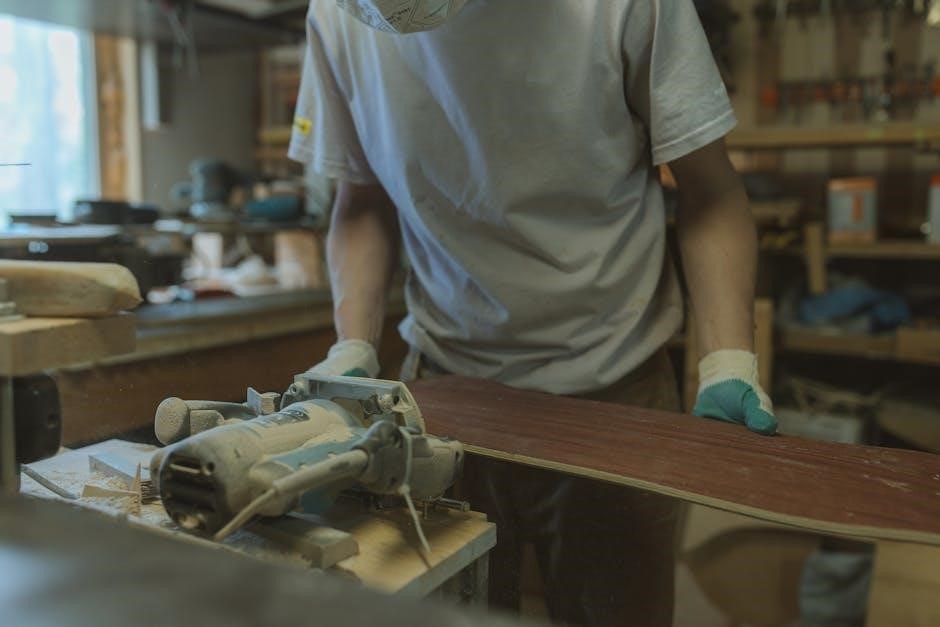
Safety Guidelines and Precautions
Always wear safety glasses and ensure loose clothing is secured. Keep the workspace clean and stable. Avoid distractions while operating the saw, and never touch moving parts. Keep a first aid kit nearby.
2.1 General Safety Tips for Using a Miter Saw
- Always keep your hands and fingers away from the blade during operation.
- Ensure the workpiece is securely clamped or held firmly to prevent movement.
- Wear safety goggles or protective eyewear to shield against debris.
- Keep loose clothing or long hair tied back to avoid entanglement.
- Maintain a clean workspace to reduce tripping hazards and improve visibility.
- Never reach over the saw blade while it is in motion.
- Use proper cutting techniques to avoid applying excessive force.
- Always follow the manufacturer’s guidelines and safety recommendations.
- Regularly inspect the saw for damage or wear and tear.
2.2 Personal Protective Equipment (PPE) Requirements
When operating the Craftsman Manual Miter Saw, wearing proper PPE is essential for safety. Safety glasses or goggles protect eyes from flying debris, while ear protection minimizes exposure to loud noises. A dust mask prevents inhalation of sawdust, and gloves provide grip and splinter protection. Steel-toe boots or sturdy footwear safeguard feet from heavy objects. Ensure all PPE fits properly and remains worn throughout the cutting process to minimize risks and maintain a safe working environment.
2.3 Safety Features of the Craftsman Manual Miter Saw
The Craftsman Manual Miter Saw includes several built-in safety features to ensure safe operation. A sturdy blade guard protects users from exposed blades, while the secure clamping system prevents material from shifting during cuts. The ergonomic handle is designed for a firm grip, reducing the risk of accidents. Additionally, the saw features a robust fence that keeps the blade aligned, minimizing kickback. These safety elements, combined with its manual design, make it a reliable choice for precise and secure cutting in various woodworking applications.
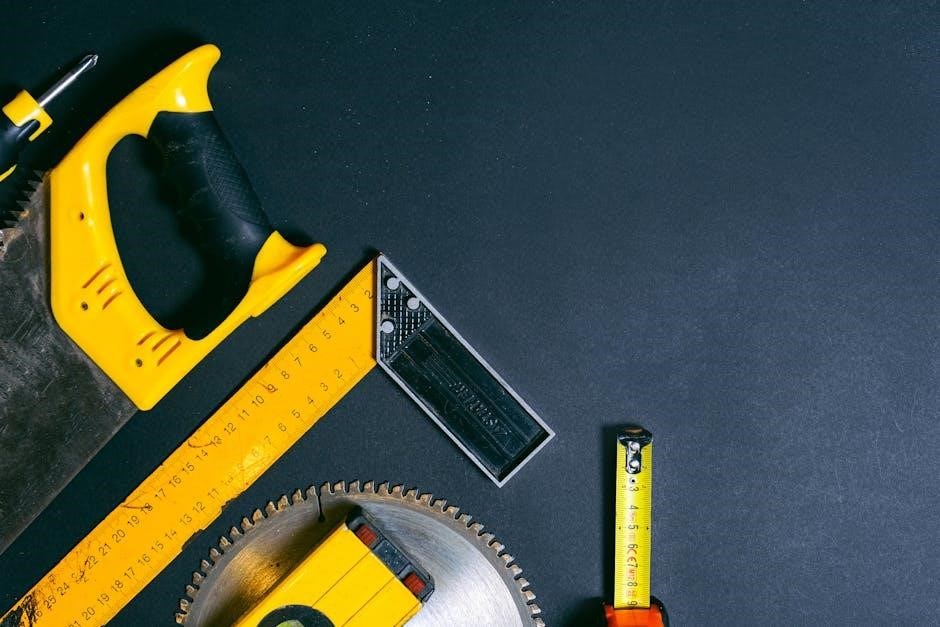
Understanding the Craftsman Manual Miter Saw
This section provides an overview of the Craftsman Manual Miter Saw, helping users understand its design, functionality, operation, and maintenance for various woodworking tasks and applications effectively.
3.1 Key Components and Parts of the Saw
The Craftsman Manual Miter Saw consists of essential components designed for precision and ease of use. The blade, typically a high-carbon steel or tungsten-carbide tipped saw blade, is central to making accurate cuts. The fence provides a stable reference for aligning materials. The miter box or frame allows for angular adjustments, while the handle enables manual operation. Additional features include a table or base for stability and adjustment knobs to calibrate blade alignment and miter angles. These parts work together to ensure consistent and precise cutting performance.
3.2 Types of Cuts You Can Make with a Miter Saw
A miter saw excels at making precise angled cuts, including miter, bevel, and compound cuts. It’s ideal for crosscuts, rip cuts, and creating decorative edges. Use it to craft perfect joints for framing, trim, and furniture. The saw’s versatility allows you to cut various materials like wood, plastic, and thin metal. Whether you’re making straight cuts or intricate angles, the miter saw delivers accuracy and consistency, making it essential for both simple and complex woodworking projects.
- Miter cuts for angled joints.
- Bevel cuts for sloped edges.
- Compound cuts combining miter and bevel angles.
- Crosscuts for precise board ends.
- Rip cuts for narrowing material.
Mastering these cuts enhances your woodworking creativity and efficiency.
3.3 Differences Between Manual and Powered Miter Saws
Manual miter saws, like the Craftsman model, rely on manual operation for precise cuts, offering greater control and cost-effectiveness. They are ideal for small projects and fine woodworking. Powered miter saws, in contrast, use electric motors for faster cuts and reduced physical effort, making them suitable for large-scale tasks. While manual saws excel in accuracy and portability, powered versions often feature advanced technology like laser guides and variable speeds. The choice between the two depends on project size, material type, and personal preference for speed versus precision.
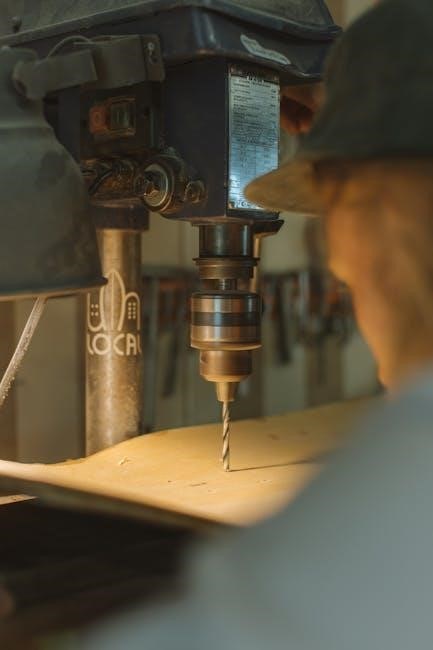
Setting Up Your Workspace
Setting up your workspace involves choosing a sturdy workbench, ensuring proper lighting, and maintaining ergonomic conditions. Organize tools and materials for efficiency and safety.
4.1 Choosing the Right Workbench for Your Miter Saw
Selecting the right workbench for your Craftsman Manual Miter Saw is crucial for stability and precision. Opt for a sturdy, level surface that can support the saw’s weight and your work materials. A workbench with a smooth, durable finish ensures easy sliding of materials. Consider the size—ensure it accommodates the saw and allows ample space for cutting. A bench with built-in storage can help keep tools and accessories organized. Prioritize a workbench made from high-quality materials like wood or metal for long-lasting durability and reliability during woodworking projects.
4.2 Proper Lighting and Ergonomics for Sawing
Proper lighting and ergonomics are essential for safe and efficient sawing. Ensure your workspace is well-lit, preferably with natural light or high-quality LED lighting, to clearly see your cuts. Position the saw at a comfortable height to avoid bending or straining. Maintain good posture by standing or sitting upright, keeping hands and arms in a neutral position. Use an anti-fatigue mat if standing for long periods. Ergonomic adjustments reduce fatigue and minimize the risk of accidents, ensuring precise and consistent results with your Craftsman Manual Miter Saw.
4.3 Organizing Your Tools and Materials
Organizing your tools and materials is essential for efficient and safe operation of the Craftsman Manual Miter Saw. Start by designating specific zones: one for cutting, one for measuring, and one for storage. Use a toolbox or pegboard to keep frequently used tools like measuring tapes, clamps, and chisels within easy reach. Store materials like lumber and hardware in labeled bins or on shelves to prevent clutter. Invest in a waste bin or vacuum system to manage sawdust and scraps. Ensure hazardous materials are stored safely and out of reach. Maintain good lighting and ergonomic placement to reduce strain and improve visibility. Regularly clean up after each session to keep your workspace tidy and functional.

Aligning and Calibrating the Saw
Proper alignment and calibration of the Craftsman Manual Miter Saw ensure precise cuts. Check blade alignment with the fence and adjust using an Allen wrench for accuracy.
5.1 How to Align the Blade with the Fence
Aligning the blade with the fence ensures accurate cuts. Start by checking if the blade is parallel to the fence using a combination square or straightedge. Loosen the fence adjustment screws and gently slide the fence until it aligns perfectly with the blade’s edge. Tighten the screws firmly to secure it in place. Double-check the alignment by making a small test cut. Proper alignment prevents uneven cuts and enhances precision. Always refer to the manual for specific adjustment procedures tailored to your Craftsman Manual Miter Saw model.
5.2 Calibrating the Miter Angle for Accuracy
Calibrating the miter angle ensures precise cuts. Start by loosening the miter lock knob and adjusting the angle to your desired setting. Use a combination square to verify accuracy. Fine-tune the angle until it aligns perfectly with the square. Tighten the lock knob securely. For consistent results, check the calibration periodically, especially after transportation or heavy use. Proper calibration is essential for achieving professional-level precision in your woodworking projects.
5.3 Adjusting the Saw for Different Materials
Adjusting the Craftsman Manual Miter Saw for various materials ensures optimal performance. For wood, use a sharp crosscut blade and set the miter angle accordingly. For metal, switch to a carbide-tipped blade and reduce cutting speed. When cutting plastic, apply light pressure and use a blade with a lower tooth count to prevent melting. Always consult the manual for material-specific blade recommendations and adjust the fence alignment for precise cuts. Proper adjustments enhance accuracy and extend the tool’s lifespan. Regularly check blade condition and alignment to maintain consistent results across different materials. Safety and precision are paramount in every adjustment.

Operating the Craftsman Manual Miter Saw
Operating the Craftsman Manual Miter Saw requires precision and control. Ensure proper alignment, hold the saw firmly, and make smooth, controlled motions for accurate cuts.
6.1 Step-by-Step Guide to Making a Cut
Position the material firmly against the fence, ensuring it aligns with your marked cutting line. Grip the saw handle steadily, placing your other hand to secure the material. Lower the blade slowly and smoothly, maintaining consistent pressure for a precise cut. Keep your movements controlled to avoid binding or unevenness. Once the blade reaches the bottom, lift it back to the starting position and remove the cut piece. Always keep your hands away from the blade during operation for safety.
6;2 Using the Laser Guide for Precision
The Craftsman Manual Miter Saw features a built-in laser guide to enhance cutting accuracy. This tool projects a red line onto your material, indicating where the blade will cut. To use it effectively, ensure the laser is aligned with your marked cutting line. Turn it on before making a cut and adjust as needed for precise alignment. The laser guide is especially useful for intricate cuts or when working with expensive materials, helping you achieve professional-level results with minimal waste. Regularly check and calibrate the laser for consistent accuracy.
6.3 Techniques for Cutting Various Materials
When using the Craftsman Manual Miter Saw, adjusting your technique based on the material is crucial. For wood, use a steady, firm motion with a fine-tooth blade for smooth cuts. Metal requires a slower, controlled approach with a specialized blade to prevent overheating. Plastic and softer materials benefit from light pressure to avoid melting or deformation. Always align the material securely and use the laser guide for precision. Experiment with feed rates and blade angles to optimize results for different densities and textures. Proper technique ensures clean, accurate cuts across various materials.
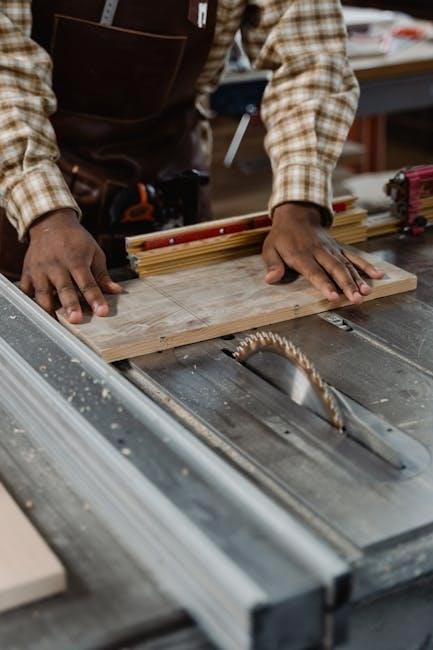
Maintenance and Care
Regular maintenance ensures optimal performance of the Craftsman Manual Miter Saw. Clean the saw, lubricate moving parts, and store it dry to prolong its lifespan.
7.1 Cleaning the Saw and Removing Debris
Regular cleaning is essential for maintaining the performance of your Craftsman Manual Miter Saw. Use a soft-bristled brush or cloth to wipe away sawdust and debris from the blade, fence, and miter box. Pay attention to crevices where dust often accumulates. Avoid using harsh chemicals, as they may damage the finish. Instead, dampen a cloth with mild soap and water for tougher grime. After cleaning, dry the saw thoroughly to prevent rust. Regular maintenance ensures smooth operation and extends the tool’s lifespan, keeping it in optimal condition for precise cuts.
7.2 Lubricating Moving Parts for Smooth Operation
Lubricating the moving parts of your Craftsman Manual Miter Saw ensures smooth operation and prevents wear. Apply a silicone-based lubricant to the hinge pins, adjustment mechanisms, and lock systems. Avoid over-lubrication to prevent attracting dust. Regular lubrication reduces friction, maintains accuracy, and extends the tool’s lifespan. Use a clean cloth to wipe off excess lubricant after application. This simple maintenance step keeps your saw functioning optimally and reduces the risk of mechanical failure during cuts.
7.3 Storing the Saw Properly
Proper storage of the Craftsman Manual Miter Saw is essential for maintaining its performance and longevity. Always clean the saw thoroughly before storing it to remove dust and debris. Use a protective cover or case to shield it from dust and potential damage. Store the saw in a dry, cool place, away from direct sunlight and moisture. Avoid leaving it in humid environments or outdoors. Ensure the saw is out of reach of children and pets. Proper storage will help preserve its accuracy and ensure it remains in excellent condition for future use.
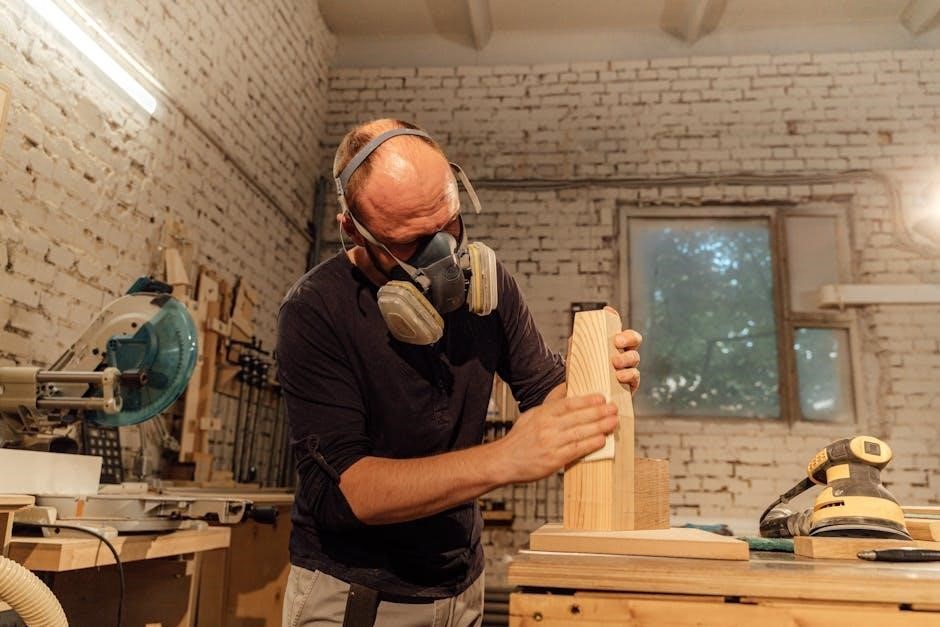
Troubleshooting Common Issues
Identify common issues like blade misalignment, miter angle inaccuracy, or cutting inconsistencies. Check for wear, ensure proper calibration, and maintain sharp blades for optimal performance and precision.
8.1 Diagnosing Blade Alignment Problems
Blade alignment issues can lead to uneven cuts and reduced accuracy. Check if the blade is parallel to the fence by measuring the distance at both ends. If misaligned, adjust the fence or blade according to the manual. Look for worn or loose parts causing misalignment. Ensure the miter saw table is level and secure. Perform a test cut on scrap wood to confirm alignment accuracy. Regularly inspect and tighten bolts and screws to prevent alignment shifts during operation. Proper alignment is crucial for achieving precise, professional results with the Craftsman Manual Miter Saw.
8.2 Fixing Issues with the Miter Angle
If the miter angle is misaligned, it can lead to uneven cuts. Start by checking the detent plates for debris or wear. Clean them thoroughly and ensure they’re free from obstructions. Next, adjust the angle stops by loosening the lock knob and realigning the miter arm. Use a combination square to verify accuracy. Tighten the lock knob firmly after adjustments. If issues persist, calibrate the angle using the saw’s adjustment screws, referring to the manual for precise instructions. Regular checks and adjustments will ensure precise miter angle performance for accurate cuts every time.
8.3 Solving Common Cutting Inaccuracies
Addressing cutting inaccuracies with the Craftsman Manual Miter Saw often involves simple adjustments. First, check if the blade is properly aligned with the fence. A misaligned blade can lead to uneven cuts. Next, ensure the saw is set to the correct miter angle and that the material is securely held in place. Dull blades can also cause inaccuracy, so replacing or sharpening the blade may be necessary. Regularly inspecting and maintaining the saw ensures precise cuts. By addressing these common issues, you can achieve consistent accuracy in your woodworking projects.
Advanced Techniques and Tips
Mastering advanced techniques with the Craftsman Manual Miter Saw enhances precision and creativity. Experiment with intricate cuts, use specialized jigs, and maintain sharp blades for optimal results. Always practice safety and patience for professional-grade outcomes.
- Practice compound cuts for complex projects.
- Utilize custom jigs for repetitive tasks.
- Refine your technique with consistent practice.
9.1 Making Compound Cuts with Precision
Making compound cuts requires precision and alignment of both miter and bevel angles. Start by setting the miter angle, then adjust the bevel to achieve the desired compound angle. Use the laser guide to ensure accuracy. Align the material firmly against the fence and blade. Practice on scrap wood to refine your technique. For intricate projects, such as crown molding, compound cuts are essential. Always double-check measurements before cutting to ensure professional results. This technique enhances your woodworking skills and expands your project possibilities with the Craftsman Manual Miter Saw.
9.2 Using Jigs and Accessories for Specialized Cuts
Enhance your craftsmanship by utilizing jigs and accessories with the Craftsman Manual Miter Saw. Custom jigs can be designed for precise angled cuts, while specialized accessories like extension fences and hold-down clamps improve stability. These tools enable intricate cuts such as dadoes, dovetails, and custom miters with greater accuracy. For repetitive tasks, jigs save time and ensure consistency. Accessories like laser guides or dust collection attachments further enhance functionality. By incorporating these, you can tackle complex projects with confidence, expanding the saw’s capabilities for professional-level results.
9.4 Tips for Achieving Professional-Level Results
To achieve professional-level results with your Craftsman Manual Miter Saw, focus on precision and consistency. Always use sharp, high-quality blades tailored to your material. Ensure the saw is properly calibrated and aligned before cutting. Maintain a clean workspace to avoid debris interference. Use jigs or clamps to stabilize materials for accurate cuts. Double-check measurements and angles to minimize errors. Practice techniques like featherboarding for straight cuts and consider using a laser guide for enhanced accuracy. Regularly maintain the saw to ensure smooth operation and extend its lifespan. Consistent practice will elevate your craftsmanship to professional standards.

Creative Projects Using the Craftsman Manual Miter Saw
Unleash your creativity with the Craftsman Manual Miter Saw by crafting custom picture frames, crown molding, and DIY furniture. Perfect for woodworking projects that require precision and style.
10.1 Building Custom Picture Frames
Building custom picture frames is a rewarding project made easy with the Craftsman Manual Miter Saw. Its precision miter cuts enable flawless 45-degree angles for seamless frame joints. Start by measuring and cutting wood strips to size, ensuring accurate miter joints for a professional finish. Sand the edges for smoothness and assemble using wood glue and clamps. For a polished look, paint or stain the frame before attaching the backing and glass. This project highlights the saw’s versatility in creating intricate woodwork with ease and accuracy, perfect for DIY enthusiasts and woodworking novices alike.
10.2 Creating Crown Molding and Trim
Crafting crown molding and trim with the Craftsman Manual Miter Saw is a breeze, thanks to its precise angle adjustments. Use the quick-adjust miter system to set 45-degree angles for professional-looking joints. The saw excels at cutting intricate profiles, ensuring smooth, splinter-free edges. For flawless results, align the material firmly against the fence and use a laser guide for accuracy. Perfect for wood or MDF molding, this tool helps create elegant trim and decorative accents for any room. Always wear safety glasses and a dust mask when working with fine materials.
10.3 DIY Furniture Projects with the Miter Saw
A manual miter saw is ideal for DIY furniture projects, offering precise angled cuts for joints and frames. Create custom coffee tables, shelves, or chairs with ease. The saw’s accuracy ensures perfect miters for seamless assemblies. Use it to craft decorative trim or molding for a professional finish. Whether building a modern desk or a rustic bench, the Craftsman Manual Miter Saw simplifies complex cuts, making furniture-making accessible to all skill levels. Its versatility allows for creative freedom, enabling you to bring your woodworking visions to life efficiently.
The Craftsman Manual Miter Saw is a reliable tool for precise cuts, offering excellent value for woodworking projects. This guide has empowered you to use it effectively and maintain it properly for lasting performance.
11;1 Summarizing the Key Features of the Craftsman Manual Miter Saw
The Craftsman Manual Miter Saw is a high-quality tool designed for precision and durability. It features an all-metal frame, a 14-inch blade, and a laser guide for accurate cuts. With adjustable miter and bevel settings, it allows for versatile cutting options. The ergonomic handle ensures comfortable use, while the clamping system secures materials firmly. Its manual operation provides control for intricate woodworking projects. Built for both professionals and DIYers, this saw delivers smooth operation and consistent results, making it a valuable addition to any workshop.
11.2 The Importance of Proper Maintenance
Regular maintenance is essential for extending the life of your Craftsman Manual Miter Saw. Proper upkeep ensures optimal performance, safety, and prevents wear and tear. Cleaning debris, lubricating moving parts, and storing the saw correctly are crucial steps. Neglecting maintenance can lead to rust, blade dulling, and mechanical failures. Routine care also enhances accuracy and reduces the risk of accidents. By prioritizing maintenance, you protect your investment and ensure the saw remains reliable for future projects. Consistent upkeep saves time, money, and frustration, keeping your tool in prime condition for years of precise cutting.
11.3 Encouraging Continuous Learning and Practice
Mastery of the Craftsman Manual Miter Saw requires dedication and consistent practice. As you gain experience, explore new techniques to refine your skills. Continuous learning allows you to unlock the tool’s full potential, ensuring precision and versatility in your projects. Stay updated with woodworking trends and experiment with different materials. Practicing regularly will enhance your confidence and craftsmanship. Embrace challenges and seek feedback to improve. The journey of learning is lifelong, and each project brings new opportunities to grow. Keep exploring, and you’ll achieve exceptional results with your Craftsman Manual Miter Saw.

Frequently Asked Questions (FAQs)
- The best blade for a manual miter saw is a high-carbon steel blade for durability and precision cutting.
- Manual miter saws are designed for woodworking, not metal cutting, due to blade limitations.
- Replace the blade every 100-200 cuts, depending on usage and material type.
12.1 What is the best blade for a manual miter saw?
The best blade for a manual miter saw depends on the type of material you’re cutting. High-carbon steel or carbide-tipped blades are ideal for woodworking, offering precision and durability. A blade with 40-60 teeth per inch (TPI) is recommended for smooth cuts in wood. For thicker or harder materials, a lower TPI blade with fewer teeth is more efficient. Always choose a blade that matches your saw’s specifications and the project requirements to ensure optimal performance and longevity of the blade.
12.2 Can I use a manual miter saw for metal?
A manual miter saw is primarily designed for cutting wood and wood-based materials. While it can technically cut metal, it is not recommended due to potential damage to the blade and saw mechanism. Metal cutting generates excessive heat and stress, which can dull or break the blade and wear out moving parts. Additionally, metal shavings may cause rust or corrosion. For metal cutting, specialized tools like metal saws or angle grinders are more suitable; Stick to woodworking projects to maintain the saw’s performance and longevity.
12.3 How often should I replace the blade?
The blade of your Craftsman Manual Miter Saw should be replaced when it shows signs of wear, such as tooth dullness or uneven cutting. Typically, this occurs after 100-200 hours of use, depending on the material being cut. If you notice difficulty making clean cuts or increased effort required, it’s time to replace the blade. Always use a high-quality replacement blade designed for your saw to maintain precision and safety; Regular inspection and timely replacement ensure optimal performance and prolong the life of your tool.